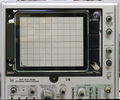5031: Difference between revisions
No edit summary |
No edit summary |
||
| Line 75: | Line 75: | ||
Tek r5031 3.jpg|R5031 Rear | Tek r5031 3.jpg|R5031 Rear | ||
</gallery> | </gallery> | ||
{{Custom ICs|5031}} | |||
[[Category:5030 series scopes]] | [[Category:5030 series scopes]] | ||
[[Category:Analog storage scopes]] | [[Category:Analog storage scopes]] | ||
[[Category:Dual beam scopes]] | [[Category:Dual beam scopes]] | ||
Revision as of 06:26, 15 March 2023
The Tektronix 5031 is a dual-beam split-screen, bi-stable storage oscilloscope introduced in 1969 (no longer listed in the 1973 catalog). There is a portable benchtop model, the 5031, and a rack-mount model, the R5031, as well as a sister model 5030/R5030 without storage. The 503x series are monolithic scopes (no plugins).
The 5030 and 5031 feature differential and current probe (for P6021) inputs on both channels. Input ranges are similar to the contemporary 3A9 diff/current amplifier plugin but without the variable bandwidth and DC offset controls. The horizontal deflection system is shared.
The 5031/5030 include a readout system which uses small lightbulb/fiber dot matrix displays external to the CRT, similar to that in the 576 curve tracer. Only the first and last steps on the time/div and volts/div switches are labelled.
Key Specifications
| Bandwidth | DC to 1 MHz (5 kHz limit switchable) |
|---|---|
| Deflection | 10 μV/Div to 10 V/Div or 1 mA/Div to 200 mA/Div (1—2—5) |
| Noise | < 15 μV / 200 μA |
| Input impedance | 1 MΩ // 50 pF |
| Time base | 1 μs/Div to 5 s/Div (1–2–5), magnifier × 1, 2, 5, 10, 20, 50 (1 μs/Div max.) |
| CMRR | 100,000:1 to 100 kHz |
| X input | 20 mV/Div to 500 mV/Div on Ext Horizontal, or Channel 2 in X-Y mode |
| CRT | 8 × 10 Div @ 1.27 cm (0.5"), P31 phosphor |
| Acceleration voltage | 4 kV |
Links
Internals
The channel-1 and channel-2 input attenuators use a rotary barrel cam that moves several small contact arms to select the desired path through the attenuator networks.
The design is similar to that seen in several 7000-series plug-ins. The front-end amplifier starts with a differential amplifier formed by both halves of a 151-1027-00 dual JFET, Q46, followed by a dual PNP. The rest of the signal path comprises differential amplifiers made of discrete BJTs, including the deflection amplifier, which uses SE7056 transistors for its output stage.
The 5031 makes extensive use of relays in the signal path.
The 5031 has −4.1 kV on the CRT cathode, and no post-deflection acceleration. The 5031 uses a T7020 CRT.
Pictures
5031
-
Tektronix 5031
-
Left view
-
Right view
-
Display detail (1)
-
Display detail (2)
-
Display detail (3)
-
Detail of fiberoptic readout module
-
Bottom view (1)
-
Bottom view (2)
-
Bottom view (3)
-
Tektronix 5031 and TDS2014
-
5031 trace
-
5031 right internal
-
5031 left internal
R5031
-
R5031 Front
-
R5031 Front Controls
-
R5031 Rear
Custom ICs used in the 5031
| Page | Model | Part nos | Description | Designers | Used in |
|---|---|---|---|---|---|
| 155-0028-00 | M018 | 155-0028-00 • 155-0028-01 • 155-0042-00 • 155-0042-01 • 155-0042-02 • 155-0042-03 | Miller integrator and delay pickoff | Joe Burger | 5030 • R5030 • 5031 • R5031 • 1401 • 1401A • 1480 • 1481 • 1482 • 1485 • 26G1 • 26G2 • 26G3 • 314 • 335 • 432 • 434 • 4701 • 5B10N • 5B12N • 5B31 • 5B40 • 5B42 • 5S14N • 7B52 • 7B53A • 7B53N • 7L12 • 7L13 • 7L14 • 7L18 • 7S14 • AN/USM-281C • RG501 • Telequipment D63 • Telequipment DM63 |
| 155-0029-01 | 155-0029-00,155-0029-01 | 155-0029-01 | Trigger | 26G1 • 26G2 • 26G3 • 4701 • 5030 • R5030 • 5031 • R5031 • 5B10N | |
| 155-0030-00 | 155-0030-00 | Storage logic | 5031 • R5031 | ||
| 155-0031-01 | M047 | 155-0031-00 • 155-0031-01 | quad timing unit | Mike Nash | 5031 • R5031 • 4002A • T4005 • 4903 |














